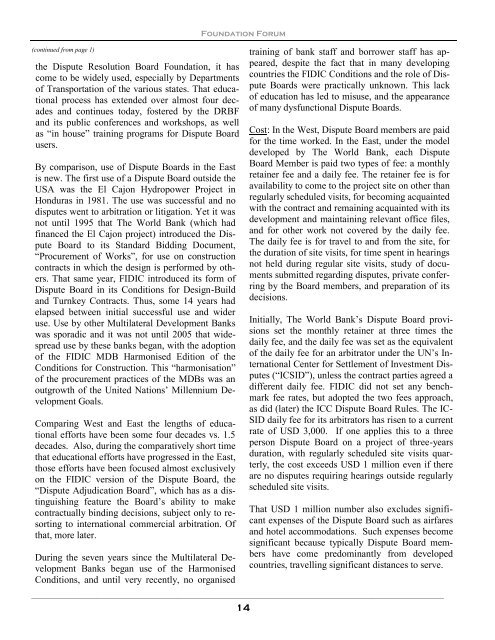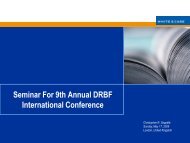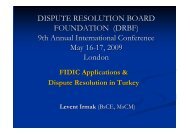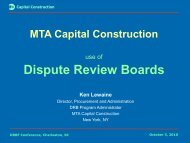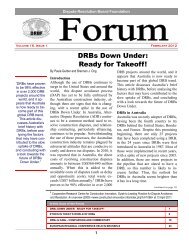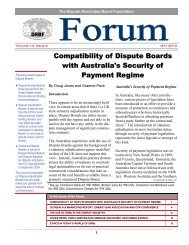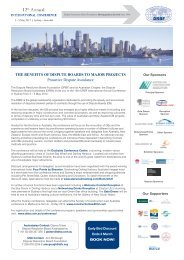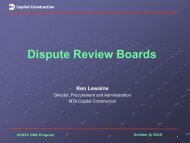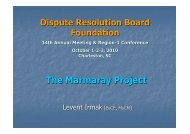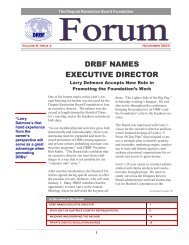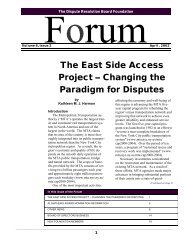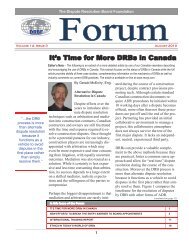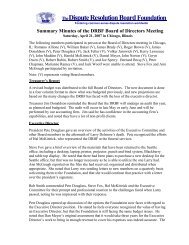Dispute Boards: East vs. West - Dispute Resolution Board Foundation
Dispute Boards: East vs. West - Dispute Resolution Board Foundation
Dispute Boards: East vs. West - Dispute Resolution Board Foundation
Create successful ePaper yourself
Turn your PDF publications into a flip-book with our unique Google optimized e-Paper software.
<strong>Foundation</strong> Forum<br />
(continued from page 1)<br />
the <strong>Dispute</strong> <strong>Resolution</strong> <strong>Board</strong> <strong>Foundation</strong>, it has<br />
come to be widely used, especially by Departments<br />
of Transportation of the various states. That educational<br />
process has extended over almost four decades<br />
and continues today, fostered by the DRBF<br />
and its public conferences and workshops, as well<br />
as “in house” training programs for <strong>Dispute</strong> <strong>Board</strong><br />
users.<br />
By comparison, use of <strong>Dispute</strong> <strong><strong>Board</strong>s</strong> in the <strong>East</strong><br />
is new. The first use of a <strong>Dispute</strong> <strong>Board</strong> outside the<br />
USA was the El Cajon Hydropower Project in<br />
Honduras in 1981. The use was successful and no<br />
disputes went to arbitration or litigation. Yet it was<br />
not until 1995 that The World Bank (which had<br />
financed the El Cajon project) introduced the <strong>Dispute</strong><br />
<strong>Board</strong> to its Standard Bidding Document,<br />
“Procurement of Works”, for use on construction<br />
contracts in which the design is performed by others.<br />
That same year, FIDIC introduced its form of<br />
<strong>Dispute</strong> <strong>Board</strong> in its Conditions for Design-Build<br />
and Turnkey Contracts. Thus, some 14 years had<br />
elapsed between initial successful use and wider<br />
use. Use by other Multilateral Development Banks<br />
was sporadic and it was not until 2005 that widespread<br />
use by these banks began, with the adoption<br />
of the FIDIC MDB Harmonised Edition of the<br />
Conditions for Construction. This “harmonisation”<br />
of the procurement practices of the MDBs was an<br />
outgrowth of the United Nations’ Millennium Development<br />
Goals.<br />
Comparing <strong>West</strong> and <strong>East</strong> the lengths of educational<br />
efforts have been some four decades <strong>vs</strong>. 1.5<br />
decades. Also, during the comparatively short time<br />
that educational efforts have progressed in the <strong>East</strong>,<br />
those efforts have been focused almost exclusively<br />
on the FIDIC version of the <strong>Dispute</strong> <strong>Board</strong>, the<br />
“<strong>Dispute</strong> Adjudication <strong>Board</strong>”, which has as a distinguishing<br />
feature the <strong>Board</strong>’s ability to make<br />
contractually binding decisions, subject only to resorting<br />
to international commercial arbitration. Of<br />
that, more later.<br />
During the seven years since the Multilateral Development<br />
Banks began use of the Harmonised<br />
Conditions, and until very recently, no organised<br />
training of bank staff and borrower staff has appeared,<br />
despite the fact that in many developing<br />
countries the FIDIC Conditions and the role of <strong>Dispute</strong><br />
<strong><strong>Board</strong>s</strong> were practically unknown. This lack<br />
of education has led to misuse, and the appearance<br />
of many dysfunctional <strong>Dispute</strong> <strong><strong>Board</strong>s</strong>.<br />
Cost: In the <strong>West</strong>, <strong>Dispute</strong> <strong>Board</strong> members are paid<br />
for the time worked. In the <strong>East</strong>, under the model<br />
developed by The World Bank, each <strong>Dispute</strong><br />
<strong>Board</strong> Member is paid two types of fee: a monthly<br />
retainer fee and a daily fee. The retainer fee is for<br />
availability to come to the project site on other than<br />
regularly scheduled visits, for becoming acquainted<br />
with the contract and remaining acquainted with its<br />
development and maintaining relevant office files,<br />
and for other work not covered by the daily fee.<br />
The daily fee is for travel to and from the site, for<br />
the duration of site visits, for time spent in hearings<br />
not held during regular site visits, study of documents<br />
submitted regarding disputes, private conferring<br />
by the <strong>Board</strong> members, and preparation of its<br />
decisions.<br />
Initially, The World Bank’s <strong>Dispute</strong> <strong>Board</strong> provisions<br />
set the monthly retainer at three times the<br />
daily fee, and the daily fee was set as the equivalent<br />
of the daily fee for an arbitrator under the UN’s International<br />
Center for Settlement of Investment <strong>Dispute</strong>s<br />
(“ICSID”), unless the contract parties agreed a<br />
different daily fee. FIDIC did not set any benchmark<br />
fee rates, but adopted the two fees approach,<br />
as did (later) the ICC <strong>Dispute</strong> <strong>Board</strong> Rules. The IC-<br />
SID daily fee for its arbitrators has risen to a current<br />
rate of USD 3,000. If one applies this to a three<br />
person <strong>Dispute</strong> <strong>Board</strong> on a project of three-years<br />
duration, with regularly scheduled site visits quarterly,<br />
the cost exceeds USD 1 million even if there<br />
are no disputes requiring hearings outside regularly<br />
scheduled site visits.<br />
That USD 1 million number also excludes significant<br />
expenses of the <strong>Dispute</strong> <strong>Board</strong> such as airfares<br />
and hotel accommodations. Such expenses become<br />
significant because typically <strong>Dispute</strong> <strong>Board</strong> members<br />
have come predominantly from developed<br />
countries, travelling significant distances to serve.<br />
———————————————————————————————————————————————————<br />
14


